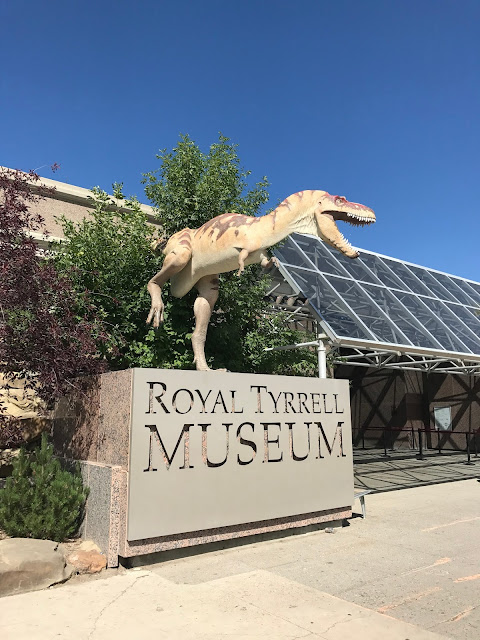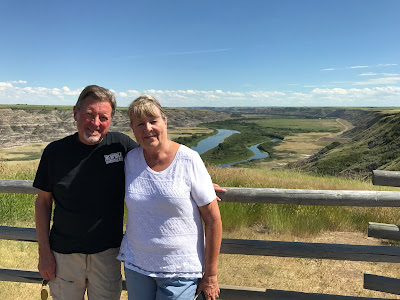Our reason for coming to Drumheller is simple: visit the Royal Tyrrell Museum. This fantastic paleontology museum has a collection of over 130,000 fossils. Operated by Alberta's Ministry of Culture, it was named in honor of Joseph Burr Tyrrell, who accidentally discovered the first reported dinosaur fossil in the Red Deer River valley in 1884. Exhibits are chronological galleries that celebrate the 3.9 billion year history of life on Earth, and contains skeletons of Tyrannosaurus rex, Stegosaurus and Triceratops, in all, more than 40 skeletons are mounted and on display.
Many sea dwelling creatures have been fossilized by unique minerals, and turned into jewel-like Ammonite.
Large and small, they've got 'em all. This is a 75 million year old Dromaeosaurus albertensis (?).
The museum's newest and proudest display is of a Nodosaur. This is the best preserved armored dinosaur in the world and is also the oldest at 110 million years of age!
This nodosaur is preserved three dimensionally with intact body armor. It preserves the original scales, skin and keratinous sheaths (horn-like tissue that covered the bony armament). This specimen was discovered by miners excavating in a oil-sands deposit that was once part of a deep sea. A land-dweller, the nodosaur was swept out to sea, where it sank and was quickly covered. It was discovered in 2011 and only recently placed on display after 7,000 hours of restoration.
Wooly Mammoths and Ankylosaurs are poised as in life.
As well as our old friend, the Stegosaurus!
One specimen was so well protected that even its eyelids had bony plates that flipped up and down. Meet Euoplocephalus:
Chasmosaurys Belli, now, was another story altogether. The large, skin covered openings, or chasms, in the frill of this dinosaur would have been to fragile for defense, so it was the only dinosaur to have small, backwardly curving orbital (eye) horns
We saw 'saurses through three floors of displays, but one is instantly recognizable:
T. Rex.
Followed closely by the famous Triceratops, the largest of the horned dinosaurs, reaching a length of about 30 feet, and weighing 13 tons!
This 20 foot long Xiphactinus (a fast and agile swimmer) has a 6 foot long Gillicus in it's stomach!
A short 1 km walk to the north of the museum led us out into the badlands.
Leaving the museum, we took a long way home, following the "Dinosaur Trail" along the Red Deer River. A peaceful view of the river caught our eye.
Probably would have been better without the stuff in the foreground...
At about 9:30 MDT we saw this beautiful cloud drift over a warm, quiet, wind-less afternoon sky.
Now, at 11:30 pm, the wind is howling at 30+ mph, the motorhome slides are retracted, lightening is danced on the adjacent hilltops, and hail is predicted later tonight! I've never seen the weather change so drastically in such a short period of time! I was talking to a neighbor earlier, when Sasha and I were out for a walk, and a gust of wind blew by. Being a local resident, she said "here comes the wind. It will be cold soon". Don't know about the cold, although it's supposed to go from a high of 88 today to a low of 42 tonite, but the wind sure knows how to blow out here in the plains!
Wish us luck! We are due to leave for Edmonton, Alberta, tomorrow, with a 20+ mph headwind. Hope we have enough fuel!

















No comments:
Post a Comment